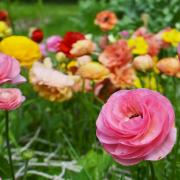As we move into high summer some groups of plants have already finished for the season, but there are many are which are still going strong. One such group is the hardy fuchsias which will carry on flowering right through until autumn if dead headed regularly.

There is a huge choice of varieties available. One of my favourites is F. genii, which has bright lime-yellow foliage, an excellent foil for the single flowers of cerise and violet. A good double-flowered variety is F. Dollar Princess, which has cerise-crimson sepals and petals of purple with red veins, on a plant which grows to around 50cm. For a variety with variegated leaves F. Tom West takes some beating; it has pale green and cream leaves with cerise veins and flowers of reddish pink and purple. Fuchsias grow well in fertile, moist, well-drained soil and prefer some shade for the hottest part of the day.
A group of climbers which enjoy the heat of high summer are abutilons. With their colourful, nodding flowers, they make good container plants for the patio in summer and conservatory in winter; they also make good garden plants if given a sunny, sheltered spot with well-drained soil where they give of their best. A good abutilon for a sunny wall or trellis is A. megapotamicum, which produces small yellow with bright red sepals over a long season (there is also a variegated form of this plant with leaves heavily mottled with yellow). A variety with stronger growth and larger flowers is A.Kentish Belle, which has purplish stems carrying bell-shaped apricot yellow flowers, lightly veined with red from summer to autumn. For a faster growing, more upright shrub, try Abutilon x Suntense, which has grey-green leaves and bears its dark violet blue or white flowers in late spring and early summer; this can grow to around 4m.
Plant of the month.

Kniphofia rooperi
Kniphofia rooperi is a strong growing red hot poker forming a clump to around 60cm across. Its magnificent flowers appear from late August to autumn and can reach up to 150cm in height. Starting out orange, they turn to the classic orange and orange- yellow as they age. It thrives in a sunny site in well-drained soil disliking waterlogging in the winter.
Question time
I have just moved into a garden with stony, chalky soil. Are there any plants which will thrive in these conditions?
There are plants for all soil types, including yours! One looking good now is Caryopteris; good varieties include Heavenly Blue, Grand Bleu and a lovely golden variegated variety Summer Sorbet. Other good plants for chalk include ceanothus, berberis, buddleja and even a rose such as Roseraie De l’Hay which has dark velvet fragrant flowers followed by large orange fruits in autumn.
Catch up with Keith
Pick sweet peas and dead head regularly for a long-lasting display.
When strawberries have finished fruiting, trim off old foliage with shears and remove unwanted runners to make room for fresh growth.
Water camellias regularly, as next year’s buds are forming now.
Trim back lavenders after flowering to maintain a compact bushy plant; don’t cut back into the old productive wood as this can result in bare patches.
Taverham Nursery Centre, Fir Covert Road, Norwich, NR9 6HT; 01603 860522; www.taverhamnursery.co.uk



























